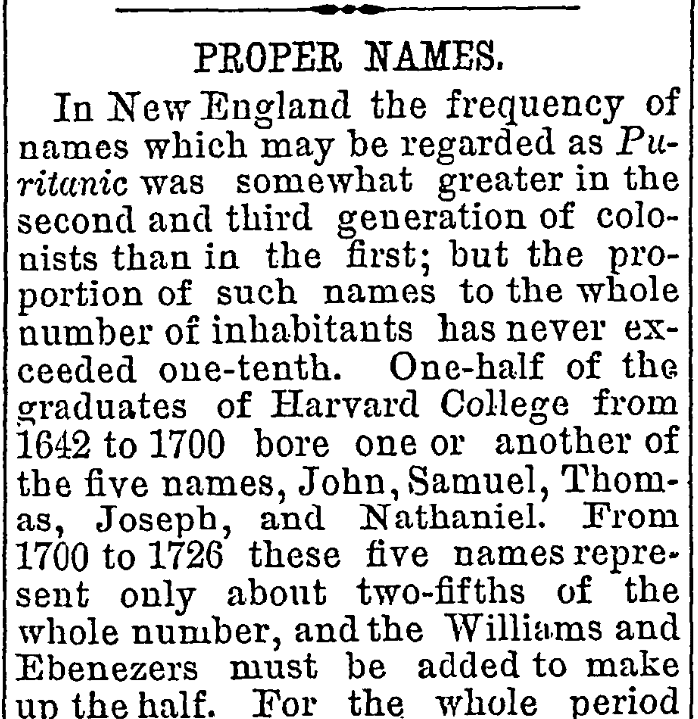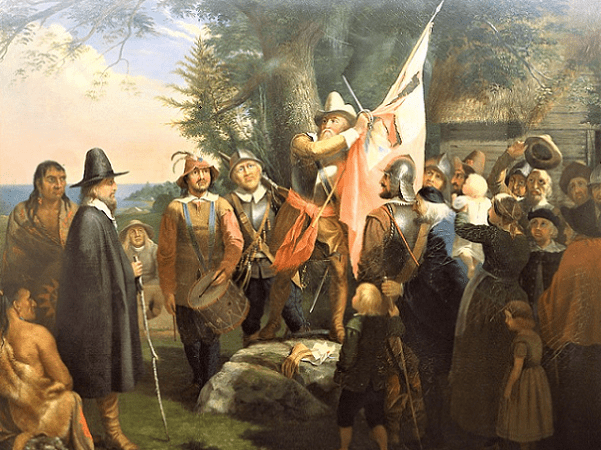Introduction: In this article, Melissa Davenport Berry searches old newspapers to find the story behind the unusual name of a woman in colonial America: Truecross. Melissa is a genealogist who has a website, americana-archives.com, and a Facebook group, New England Family Genealogy and History.
In 1874 the Congregationalist published an article on early New England names, pointing out that five simple, straightforward names were the most common in the earliest days: John, Joseph, Nathaniel, Samuel, and Thomas. William and Ebenezer were soon added to that list.

However, during this early period there were some unusual names as well, especially ones that commemorated an event of colonial or personal history.
An example was a woman named Truecross Davenport – and therein lies a tale.
As the article explained:

The event associated with the name Truecross took place during a military drill in 1634 in the town of Salem, Massachusetts. Richard Davenport was the ensign [flag] bearer and John Endicott (also spelled Endecott) was his captain. At the start of a drill one November day Endicott grabbed the flag and cut out the red patron cross of St. George with his sword. Endicott’s defiant act against “popish relics of superstition” made clear his desire to sever customs and binds to “Episcopacy England.’
In 1841 the National Aegis newspaper published an article titled “The Red Cross” that told the story of Endicott’s act, beginning with a conversation between Roger Williams and Endicott.
Endicott, “a prompt and resolute man,” took action. The newspaper reported:
When they learned of Endicott’s action, local officials were concerned. John Winthrop wrote in his journal entry for 5 November 1634: “At the court of assistants complaint was made by some of the country that [the] ensign was defaced at Salem. Upon this, attachment was awarded against Richard Davenport, ensign bearer, to appear at next court” to bear testimony against Endicott.
Endicott’s action might have been judged as an act of treason and cost him his life. As the National Aegis reported:
Endicott was reprimanded for his act and disqualified from office for the span of one year. However, it did not take long for Endicott to reenter the Puritan political fold and climb the ladder. He became the longest-serving governor of the Massachusetts Bay Colony, serving for 16 years.
One must love the irony: the radical Endicott turned into a repressive tyrant. He had zero tolerance for anyone who stood in his way. Endicott was more dictator than liberator. He campaigned against long hair, banished Roger Williams, tortured Quakers, and cut down the may poll at Merry Mount (Quincy, Massachusetts). John Greenleaf Whittier wrote that Endicott was:
“A grave strong man, who knew no peer. In the pilgrim land, where he ruled in fear. Of God, not man, and for good or ill. Held his trust with an iron will.”
And what of the ensign bearer, Richard Davenport? After the incident Richard became known as Ensign Davenport. His daughter Truecross, born shortly after, was named to honor the event which Nathaniel Hawthorne called “the first omen of that deliverance which our fathers consummated.” John Goff, Salem historian, suggested that Truecross had been named for Davenport’s convictions that the “true-cross” of the Puritans was an understanding of Christianity and not merely a symbol. Truecross Davenport (1634-1692) married Stephen Minot, son of Elder George Minot.
The Davenport family is found in Nathaniel Hawthorne’s family tree. Nathaniel’s paternal ancestor, great-great-great grandfather William Hathorne, sailed in the summer of 1630 on the Arbella, flagship of Winthrop’s fleet, and brought with him a sister: Elizabeth Hathorne, who married Richard Davenport!
Note: An online collection of newspapers, such as GenealogyBank’s Historical Newspaper Archives, is not only a great way to learn about the lives of your ancestors – the old newspaper articles also help you understand American history and the times your ancestors lived in, and the news they talked about and read in their local papers. Have you uncovered any unusual names for your ancestors – and the stories of how they got those names? Please share your stories with us in the comments section.
Explore over 330 years of newspapers and historical records in GenealogyBank. Discover your family story! Start a 7-Day Free Trial
Further Reads:
- Young, Alexander. “Chronicles of the First Planters of the Colony of Massachusetts Bay, from 1623 to 1636.” Genealogical Publishing Company Baltimore, Maryland, 1975.
- Davenport, Henry. “Additional Notices of Eleazer and Richard Davenport.” The New England Historical and Genealogical Register, October 1850, No. 4.
- “The Cross Cut Out by John Endicott of Salem and by Sir Harry Vane at Boston as a Superstitious Thing and a Relic of Antichrist; The Military Commissioners Order the ‘Cross Out of All Colors.’” The American Catholic Historical Researches, New Series, Vol. 5, No. 4 (October 1909), pp. 321-331 (11 pages).
- Hawthorne, Nathaniel. Twice-Told Tales: “The Red Cross.” V. 2. 1851.
- Goff, John. “Salem’s Witch House: A Touchstone to Antiquity.” Arcadia Publishing, 16 September, 2009.
